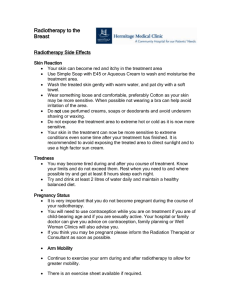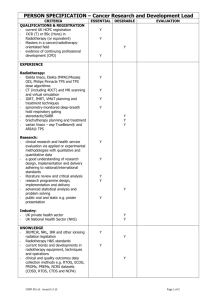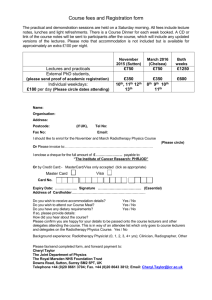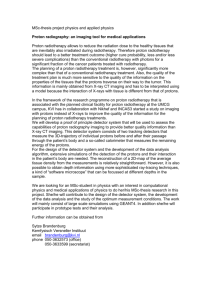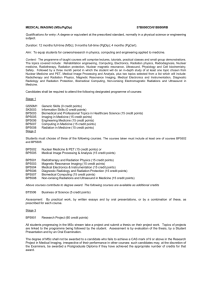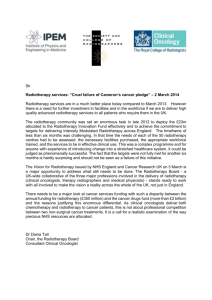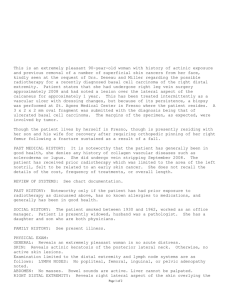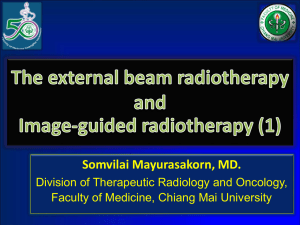Automatic Image Registration Software for Radiotherapy planning
advertisement
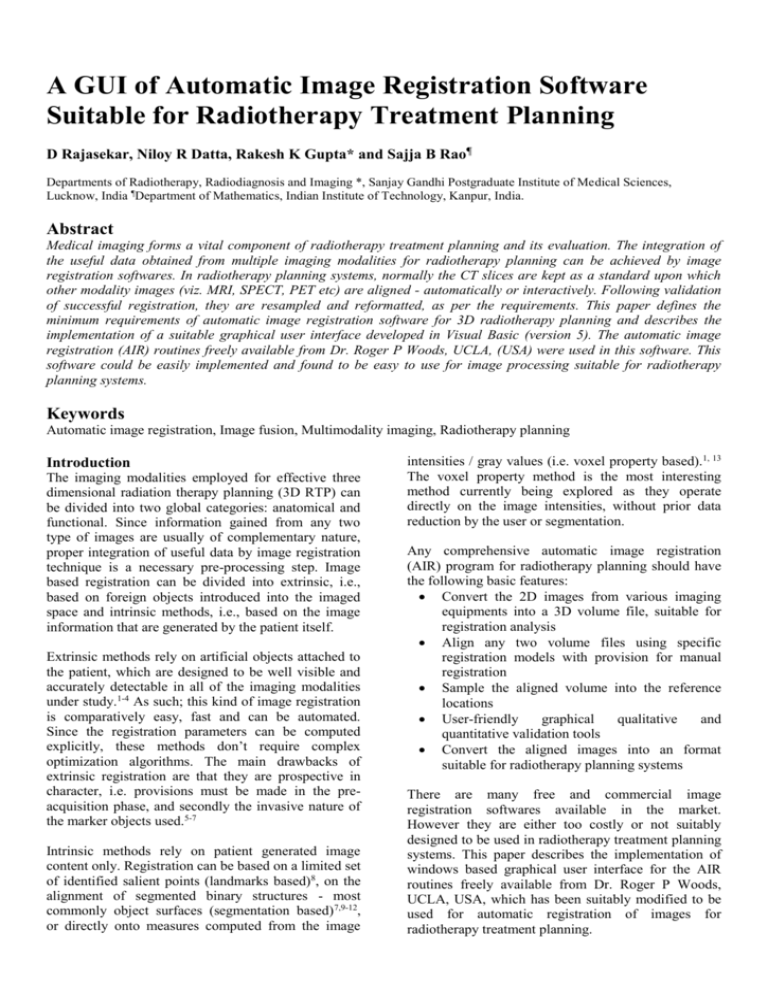
A GUI of Automatic Image Registration Software Suitable for Radiotherapy Treatment Planning D Rajasekar, Niloy R Datta, Rakesh K Gupta* and Sajja B Rao¶ Departments of Radiotherapy, Radiodiagnosis and Imaging *, Sanjay Gandhi Postgraduate Institute of Medical Sciences, Lucknow, India ¶Department of Mathematics, Indian Institute of Technology, Kanpur, India. Abstract Medical imaging forms a vital component of radiotherapy treatment planning and its evaluation. The integration of the useful data obtained from multiple imaging modalities for radiotherapy planning can be achieved by image registration softwares. In radiotherapy planning systems, normally the CT slices are kept as a standard upon which other modality images (viz. MRI, SPECT, PET etc) are aligned - automatically or interactively. Following validation of successful registration, they are resampled and reformatted, as per the requirements. This paper defines the minimum requirements of automatic image registration software for 3D radiotherapy planning and describes the implementation of a suitable graphical user interface developed in Visual Basic (version 5). The automatic image registration (AIR) routines freely available from Dr. Roger P Woods, UCLA, (USA) were used in this software. This software could be easily implemented and found to be easy to use for image processing suitable for radiotherapy planning systems. Keywords Automatic image registration, Image fusion, Multimodality imaging, Radiotherapy planning Introduction The imaging modalities employed for effective three dimensional radiation therapy planning (3D RTP) can be divided into two global categories: anatomical and functional. Since information gained from any two type of images are usually of complementary nature, proper integration of useful data by image registration technique is a necessary pre-processing step. Image based registration can be divided into extrinsic, i.e., based on foreign objects introduced into the imaged space and intrinsic methods, i.e., based on the image information that are generated by the patient itself. Extrinsic methods rely on artificial objects attached to the patient, which are designed to be well visible and accurately detectable in all of the imaging modalities under study.1-4 As such; this kind of image registration is comparatively easy, fast and can be automated. Since the registration parameters can be computed explicitly, these methods don’t require complex optimization algorithms. The main drawbacks of extrinsic registration are that they are prospective in character, i.e. provisions must be made in the preacquisition phase, and secondly the invasive nature of the marker objects used.5-7 Intrinsic methods rely on patient generated image content only. Registration can be based on a limited set of identified salient points (landmarks based)8, on the alignment of segmented binary structures - most commonly object surfaces (segmentation based)7,9-12, or directly onto measures computed from the image intensities / gray values (i.e. voxel property based).1, 13 The voxel property method is the most interesting method currently being explored as they operate directly on the image intensities, without prior data reduction by the user or segmentation. Any comprehensive automatic image registration (AIR) program for radiotherapy planning should have the following basic features: Convert the 2D images from various imaging equipments into a 3D volume file, suitable for registration analysis Align any two volume files using specific registration models with provision for manual registration Sample the aligned volume into the reference locations User-friendly graphical qualitative and quantitative validation tools Convert the aligned images into an format suitable for radiotherapy planning systems There are many free and commercial image registration softwares available in the market. However they are either too costly or not suitably designed to be used in radiotherapy treatment planning systems. This paper describes the implementation of windows based graphical user interface for the AIR routines freely available from Dr. Roger P Woods, UCLA, USA, which has been suitably modified to be used for automatic registration of images for radiotherapy treatment planning. Materials and Methods The AIR routines freely available from Dr. Roger P Woods, UCLA, (USA) is a widely used software in image processing field. These software routines can be downloaded freely from the website: (http://bishopw. loni.ucla.edu/AIR5/index.html). However, these software routines are for general-purpose image registration purpose, not optimally designed for radiotherapy planning. It is too cumbersome and timeconsuming to use these AIR programs in routine clinical applications. To facilitate easy image registration process with the mandatory requirements stated above, an in-house automatic image registration software (AIRwin) with user-friendly graphical user interface (GUI) have been developed using Visual Basic (version 5) compiler. The AIR programs can handle only images of a specific format (i.e. 8 or 16 bit binary matrix of specified size with the corresponding header information in a separate file). Since it is time consuming and error prone to manually convert each image into format suitable for AIR module or into TPS compatible formats, a simple software command should be added in the GUI. The registration process should be able to align images of 2D or 3D types. A 2D-linked cursor tool which is the simplest of all and can be used for qualitative and quantitative validation of registration, has been proposed included the GUI. The header intensities would adversely affect the registration accuracy from image obtained from hard copy films, a simple method should be designed to properly remove them prior to image registration. Appropriate graphic controls were proposed for easy conversion of images suitable for radiotherapy planning systems. Results The ‘AIRwin’ software was developed with userfriendly GUI with modules for 'Automatic Image Registration' (Fig. 1) and 'Validate Registration' (Fig. 2). Various steps in registration of medical images as discussed in the material methods section were grouped in these modules for easy of use and workflow. All the executable AIR functions were kept in a separate directory, which could be modified by the user. The mandatory and optional parameters necessary for various functions and generic error messages could be downloaded from the AIR5 website. Using the ‘Validate Registration’ module, one can covert the images files from popular formats into AIR format. Currently the ACER-NEMA (*.ima), DICOM (*.dcm), windows gray scale bitmap (*.bmp), float numbers (*.flt) images can be converted into the AIR format. These image files can be selected from the file list control (single or multiple files) and the corresponding (*.img) files can be created by ‘Save AIR’ button. The header files (*.hdr), corresponding to these ‘*.img’ files can be created in ‘Automatic Image Registration’ module using ‘Make Header’ button, after entering appropriate header data. The ‘Create Volume’ button combines selected 2D image files into a single 3D-volume file with the name entered in the text box. The header information can be verification through the ‘View header’ command button. The default global maximum value can be changed using 'Set Max' command. Fig 1. Automatic Image Registration module of ‘AIRwin’ software. Automatic Image Registration The most important function in this software is 'Auto Register' -- the registration function. Any two image or volume files can be used for 2D or 3D automatic registration process respectively. One among them can be kept as a reference image / volume and the other image / volume (test / register volume) is transformed and made to align with the reference image / volume in this process. The resulting transformation parameters in the output file depend on the registration model selected and other optional parameters that can be entered in the ‘Auto Register’ section. The output from the 'Auto Register' process, i.e. information regarding input and output volumes / images and optional parameters as well as resultant transformation parameters, etc., are stored in the output file (*.air) entered in the corresponding text box. The function 'Manual Register' is the only interactive program in this module, which requires the operator to specify values for x_shift, y_shift, and z_shift, x_rotation, y_rotation, z_rotation, x-axis_scaling, yaxis_scaling and z-axis_scaling. These values can then be stored in an initialization file for use with the 'Auto Register' function. Alternatively, these values can be used to manually generate an 'air file' or to manually 'Reslice' a volume file according to these parameters without generating an "air file". Validation of automatic registration In 'Validate Registration' module a set of 'reference' and 'registered' 2D slices can be selected from the respective list boxes and they are displayed in the picture boxes and are verified graphically using a linked cursor display (Fig. 2). Fig 2. Validation module of AIRwin software showing the reference (pre-RT T2-wt MRI) and registered (post-RT T2-wt MRI) axial slices with the linked cursor validation tool. A simple software tool ‘BMPview’ was designed to delete the header information from the scanned images (Fig. 3). Using this software tool a polygon can be drawn interactively using the mouse covering only the patient generated intensities and filling the image area outside the polygon with background intensity leaving patient generated intensities intact. accurately aligning the information in the different images, and providing tools for visualizing the combined images. The process of integrating information from different imaging modalities can be divided into two main tasks. The first task is to estimate the transformation parameters (rotation, translation and scaling vectors) that relate the coordinates of any two imaging studies. The second task is to apply the resultant transformation to map structures or features of interest from one imaging study to another or to reformat the images from one study to match the orientation and scale of the images of the other. The set of nine parameters can be estimated to for the necessary transformations are: three rotation angles (Ax, Ay, Az), three translation values (Tx, Ty, Tz) and three scaling factors (Sx, Sy, Sz). The rotation and translation parameters account for differences in orientations and location of the patient with the different imaging devices.5, 10 The scaling parameters are included to account for possible mis-calibrations of the imaging devices. In theory, all machine calibration parameters should be determined before hand and used to correct the imaging data before integration or be made available as known parameters to incorporate them into the integration process. The current version of the ‘AIRwin’ software used the following AIR routines: makeaheader, viewheader, setmax, alignlinear, scanair, reunite, reslice and separate. For each process, it created a batch file with appropriate AIR command with the mandatory factors and optional parameters as per the selection of the user. After successful creation, these batch files were executed. The description of the basic command line and the various mandatory / optional parameters could be downloaded from the AIR website (http://bishopw. loni.ucla.edu/AIR5/index.html). Discussions The validation registration of images is absolutely indispensable in any automatic registration process. Currently research is going on in area with user friendly modules to validate the results such as orthogonal view with curtain / eraser, spy glass tool, checker board view, 3D linked cursors etc. Validation of a registration includes more than just the accuracy verification. The list of items includes must be: precision, accuracy, robustness / stability, reliability, resource requirements, algorithm complexity, assumption verification and clinical use.14 Medical images are increasingly being used within healthcare for diagnosis, planning treatment, guiding treatment and monitoring disease progression. In many of these studies, multiple images are acquired from subjects at different times, and often with different imaging modalities. Computerized integration of these images has great potential benefits, particularly by Although, a number of similar softwares are routinely available as a part of the commercial 3D treatment planning systems, the user may not have much choice of individualizing the functions of the software to his / her requirements. Moreover, these are available always at a price, which could be difficult to procure for a Fig 3. The ‘BMPview’ software tool used for preprocessing hard copy films scanned from a film scanner. routine department especially of a developing country. The effort made in this study demonstrates that one can successfully use the benefit of certain freely available image registration software available on the Internet to work on various aspects of image registration to tailor make to meet the requirements of a department. (This software along with the source code can be freely supplied upon request to: drsekar@ sgpgi.ac.in). Conclusions The major application areas of automatic registration currently are in radiation therapy and neurosurgery. The modifications made in the AIR programs as discussed in this study is currently being used in the department and has been found to be very much useful for three-dimensional radiotherapy planning. This software contains self-explanatory controls that can be operated by any person with a reasonable image processing experience. Acknowledgements: The Authors would like to thank Dr. Roger P Woods, UCLA, (USA) and his team for making the AIR programs freely available though their website and allowing us to use part of the AIR user manual in this manuscript. References [1] Ardekani BA, Braun M, Hutton E, Mayes A, Sagar HJ. 1995. A fully automatic multimodality image registration algorithm. J Comput Assist Tomogr 19: 615 - 23. [2] Kooy HM, Herk MV, Barnes PD. 1994. Image fusion for stereotactic radiotherapy and radiosurgery treatment planning. Int J Radiat Oncol Biol Phys 28: 1229 - 34. [3] Mongioi V, Brusa A, Loi G, Pignoli E, Gramaglia A, Scorsetti M, Bombardieri E, Marchesini R. 1999. Accuracy evaluation of fusion of CT, MR, and SPECT images using commercially available software packages (SRS Plato and IFS). Int J Radiat Oncol Biol Phys 43: 227 - 34. [4] Pietrzyk U, Herholz K, Fink G, Jacobs A, Mielke R, Slansky I, Wuker M, Heis W. 1994. An interactive technique for three dimensional image registration: validation for PET, SPECT, MRI and CT brain studies. J Nucl Med 35: 2011- 18. [5] Hill DLG, Batchelor PG, Holden M, Hawkes DJ. 2001. Medical Image Registration. Phys Med Biol 46: R1 - R45. [6] Ten Haken RK, Thornton AF, Sandler HM, La Vinge ML, Quint DJ, Fraass BA, Kessler ML, McSchan DL. 1992. A quantitative assessment of the addition of MRI to CT based 3D treatment planning of brain tumors. Radiother Oncol 25: 121- 33. [7] Turking TG, Hoffman JM, Jasczak RJ, MacFall JR, Harris CC, Kilts CD, Pellizari CA, Coleman RE. 1995. Accuracy of surface fit registration for PET and MR brain images using full and incomplete brain surfaces. J Comput Assist Tomogr 19: 117 - 124. [8] Birnbaum BA, Noz ME, Chapnick I. 1991. Hepatic hemangiomas: diagnosis with fusion of MR, CT and 99mTc-labeled red blood cell SPECT images. Radiology 181: 469 - 474. [9] Herk MV, Kooy HM. 1994. Automatic threedimensional correlation of CT-CT, CT-MRI, CTSPECT using chamfer matching. Med Phys 21: 1163 - 78. [10] Pelizzari CA, Chen GTY, Spelbring DR, Weichselbaum RR, Chen CT. 1989. Accurate three-dimensional registration of CT, PET and / or MR images of the brain. J Comput Assist Tomogr 13: 20 - 26. [11] Kessler ML, Pitluck S, Petti P, Castro JR. 1991. Integration of multimodality imaging data for radiotherapy treatment planning. Int J Radiat Oncol Biol Phys 21: 1653 - 67. [12] Petti PL, Kessler ML, Fleming T, Pitluck S. 1994. An automated image-registration technique based on multiple structure matching. Med Phys 21: 1419 - 26. [13] Woods RP, Mazziotta JC, Cherry SR. 1993. MRIPET registration with an automated algorithm. J Comput Assist Tomogr 17: 536 - 46. [14] Maintz JBA. 1996. Retrospective registration of tomographic brain images. PhD Thesis, Utrecht University. [15] Harrington S. 1987. Computer graphics: A programming approach. 2 ed. McGraw-Hill Book Company, New Delhi. pp 70 - 141.
